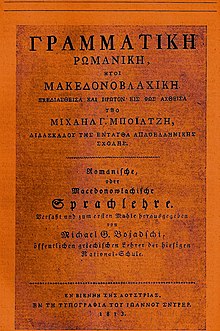
Mihail George Boiagi[1] (3 February 1780 – 1828,[2] 1842 or 1843[3]) was an Aromanian grammarian and professor in the Habsburg monarchy and the Austrian Empire. He was born on 3 February 1780 in Buda, today Budapest in Hungary. Boiagi was one of the first grammarians from the Balkans and a professor in a school in Vienna,[2] where he taught Greek. He had origins from Moscopole, today in Albania.[1] Boiagi was one of the main figures of the Aromanian diaspora in Austria and Hungary, the capitals of which, Vienna and Budapest respectively, became gathering centers for members of this community in the 19th century. Boiagi introduced the Aromanian historian Dimitrie Cozacovici to the Aromanian community of Austria and Hungary after Cozacovici's migration from Metsovo, today in Greece, to Buda.[4]
In 1813, in Vienna, Boiagi published the grammar book Γραμματική Ρωμαϊκή ήτοι Μακεδονοβλαχική/Romanische oder Macedonowlachische Sprachlehre ("Romance or Macedono-Vlach Grammar"). Written in German and Greek, although with texts in Aromanian, it introduced the first writing system for the Aromanian language in the Latin alphabet; prior to this, Aromanian had been written with the Greek script. This system was characterized by the use of digraphs to avoid the use of diacritics for those sounds not present in the Latin alphabet. Thus, instead of using e.g. "č", "ľ", "ń" or "ș", Boiagi made use of "cs", "lj", "nj" and "sh". The Greek letter "θ" was rendered as "th". However, some diacritics were included in the system, namely "â", "ç" and "ĵ". His writing system was not adopted by any authors after the publication of his grammar.[5] The book's preface elaborated on the common Roman origin of Romanians and Aromanians.[6] The Greek Ecumenical Patriarchate of Constantinople, disapproving of his work, blacklisted Boiagi's grammar and excommunicated him, although he kept his post as professor in Vienna.[3] Boiagi died in either 1828,[2] 1842 or 1843.[3]
Other works:[7]
- Orbis Pictus de Amos Comenius, published in 1819 at Vienna
- Scurtă gramatică neogreacă pentru junimea greacă și pentru germani, Vienna, 1821
His Grammar was published posthumous, in 1863, at Bucharest by Dimitrie Bolintineanu, financed by Costache Negri.[8]
See also
References
- ^ a b Bolintineanu, Dimitrie (1863). Călătorii la românii din Macedonia și muntele Athos sau Santa-Agora (in Romanian). Vol. 34. Tipografia Jurnalului Naționalul.
- ^ a b c Lala, Tașcu (2 February 2022). "Mihail G. Boiagi (03.02.1780 - 1828)" (in Aromanian). Radio Romania International. Archived from the original on 29 March 2024.
- ^ a b c Theodorescu, Răzvan; Barrows, Leland Conley (2001). Politics and Culture in Southeastern Europe. UNESCO-CEPES. ISBN 9789290691617.
- ^ Crețulescu, Vladimir (2015). "The Aromanian-Romanian national movement (1859-1905): an analytical model". Balcanica Posnaniensia. Acta et studia. 22 (1): 99–121. doi:10.14746/bp.2015.22.8.
- ^ Saramandu, Nicolae (2000). "Sisteme de scriere a aromânei". Studii și cercetări lingvistice (in Romanian). 51 (1): 199–204. ISSN 0039-405X.
- ^ Creţulescu, Vladimir (1 January 2016). "Les origines du discours identitaire Aroumain-Roumain (1770-1878) : la construction d'une identité nationale". Ph.D. thesis (University of Bucharest - History; University of Bordeaux - Political Science).
- ^ Dumbravescu, Nicolae. Mișcări național-culturale în spațiul central european. Mihai Boiagi și aromânii.
- ^ Samargiu, Nancy. "dem abeleanu neamul aromanesc din macedonia". academia.edu. Retrieved 25 February 2025.
External links
- Γραμματική Ρωμαϊκή ήτοι Μακεδονοβλαχική/Romanische oder Macedonowlachische Sprachlehre (in Greek and German)








